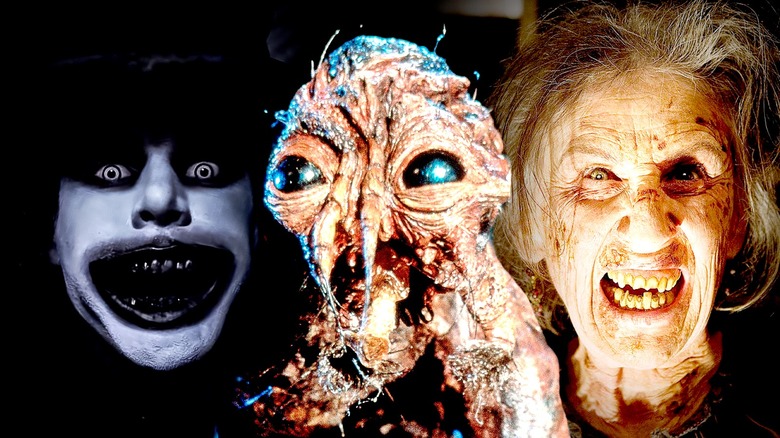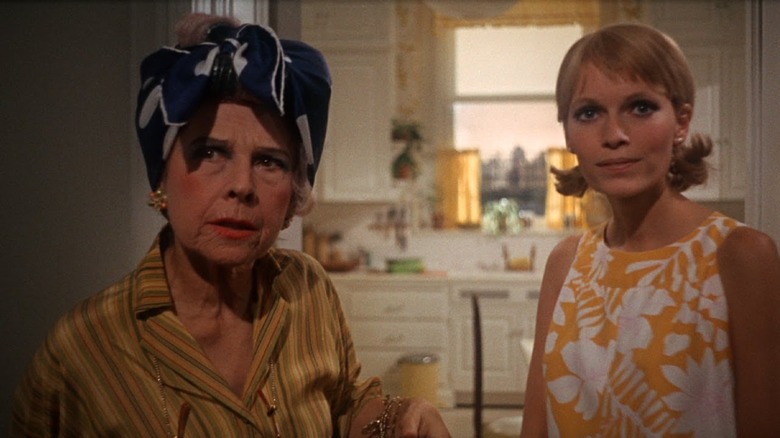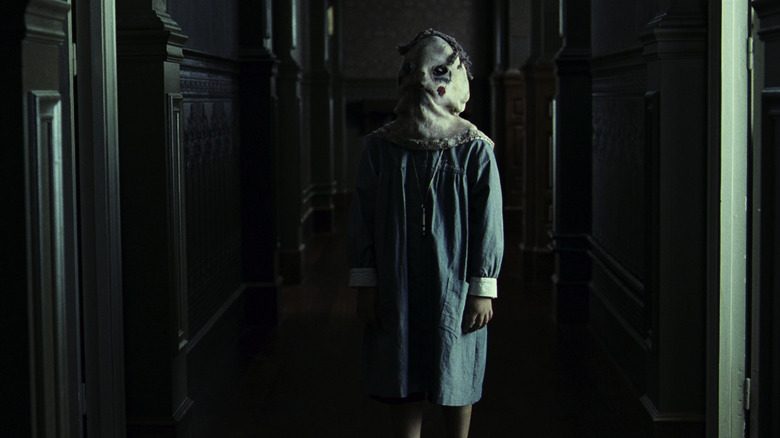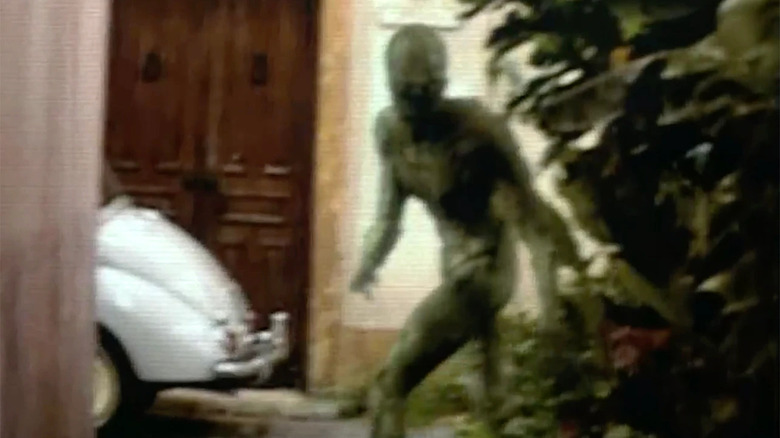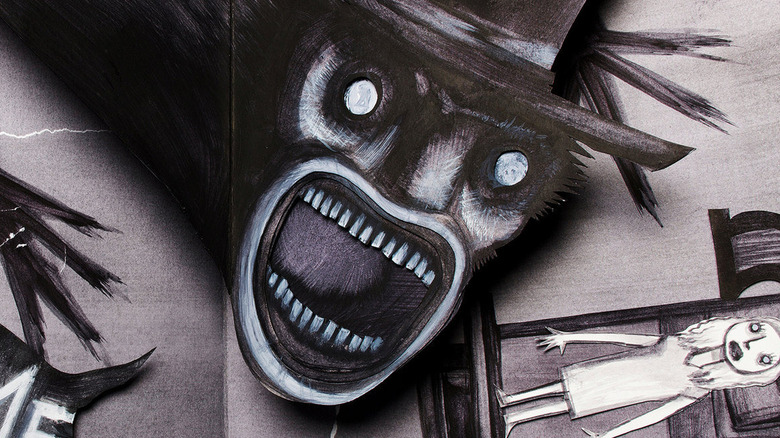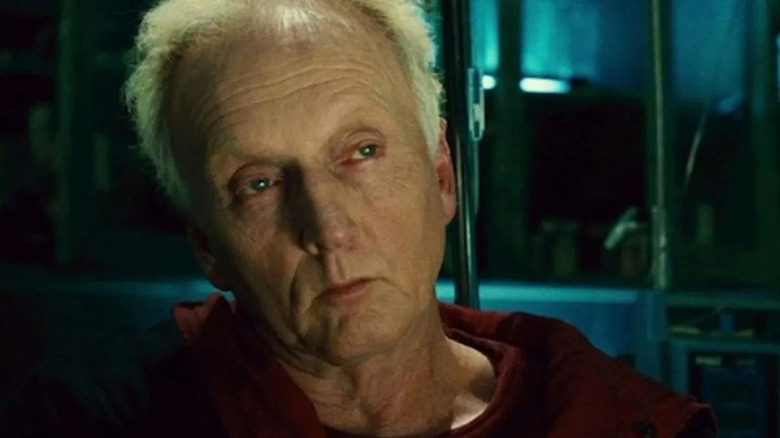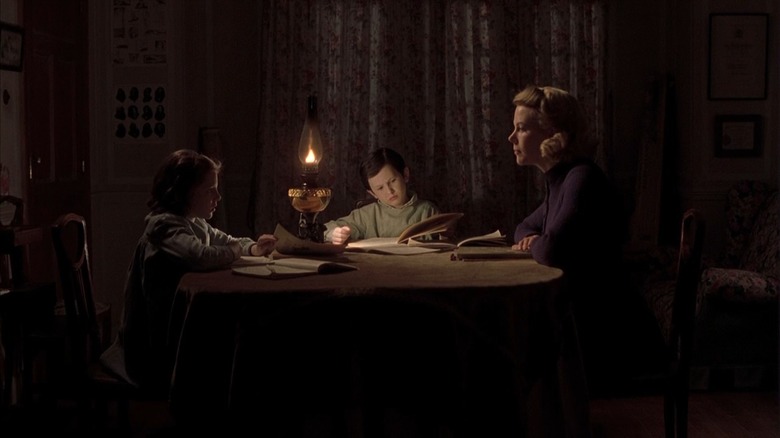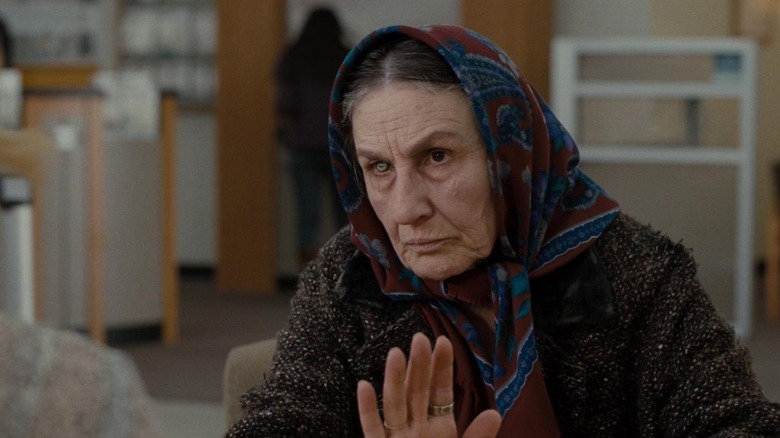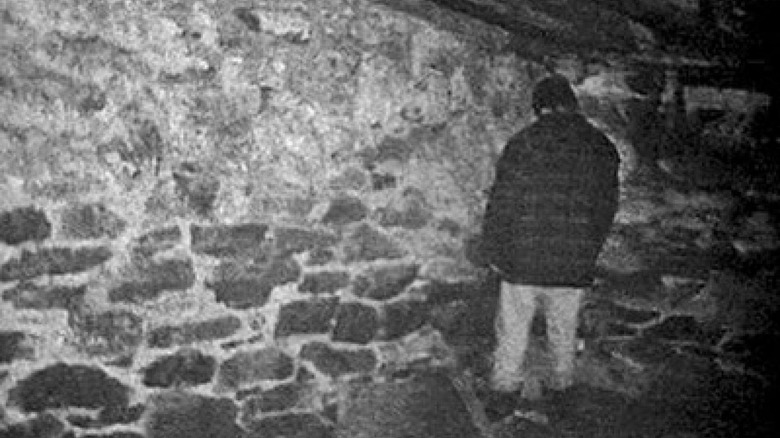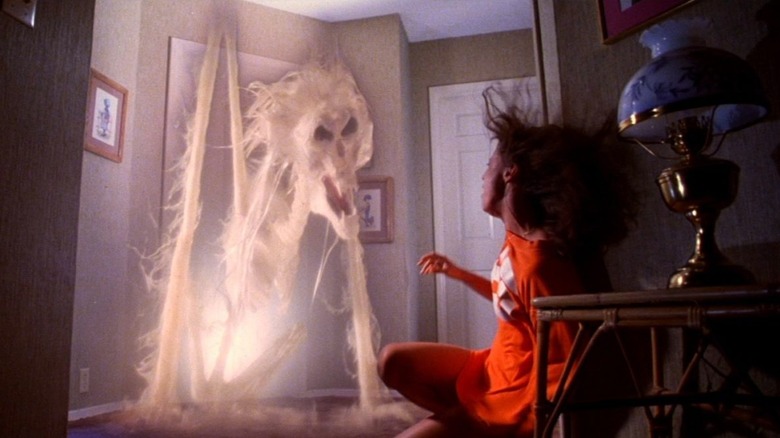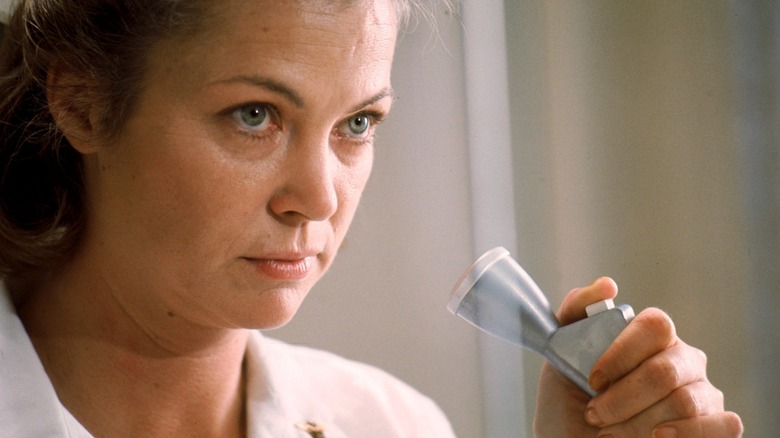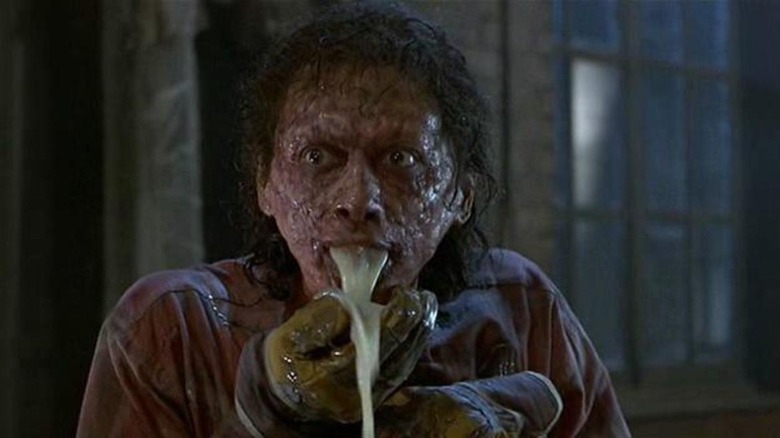Horror Movie Villains That Never Actually Killed Anyone
Horror films are a genre almost as old as cinema itself, with 1896's "Le Manoir du Diable" having the distinction of being the first film to terrify audiences, at just three minutes long and still decades before cinema would leave behind the silent film era. Movies have certainly come quite a long way from their earliest days, but one thing that has stayed true throughout much of horror movie history over the years is that you're practically guaranteed to watch someone meet their doom before the film's conclusion.
Of course, not every film falls into this pattern, and not even every horror movie antagonist winds up drawing blood. Below, we'll be rounding up some of the most memorable and terrifying villains across horror movie history, who for one reason or another never actually killed anyone. We'll do our best to avoid spoilers for most of these, but it's almost impossible to talk about these horror movie baddies without at least somewhat delving into their actions.
Minnie Castevet
First up and the first released pick on our lineup at over 50 years old, "Rosemary's Baby" is true classic horror. Though highly controversial, and not just due to the scandal surrounding its director Roman Polanski, the film has endured as one of the best-received horror movies in cinema history.
Taking place in the heart of New York City, audiences follow Rosemary (Mia Farrow) and Guy Woodhouse (John Cassavetes), a married couple looking to start a family in the bustling city. The eerie autumn weather combines with a foreboding warning from their new landlord Hutch (Maurice Evans) about their new apartment's unsavory history, which they opt to ignore. The couple soon meets their new neighbors the Castevets, who, despite making a good first impression, are hiding a truly wicked secret from the world. Front and center is Minnie Castevet (Ruth Gordon), whose sweet and helpful demeanor over the course of the film towards the now expectant Rosemary serves as the perfect cover for her true motives for both the Woodhouses and their unborn baby.
While the coven at large that Minnie belongs to is certainly responsible for at least a few direct murders, Minnie herself can plausibly deny her direct involvement in any of them. Instead, the true evil she possesses lies in her ability to deceive and manipulate those around her — not to mention helping to bring to life the literal spawn of Satan by the film's end.
Tomás
In recent years, studios like the renowned arthouse A24 have helped give rise to a new era of horror films that time and time again defy both convention and expectation. While that's provided a breath of fresh air for a genre that for too many years was saturated by dime-a-dozen slashers and tired clichés, it doesn't mean that the basics can't still work too. If you still need convincing, look no further than 2007's "The Orphanage," a title that remains one of the best gothic horror flicks in recent memory.
Set on the grounds of a historic Spanish orphanage, a former resident of the sprawling property Laura Rodriguez (Belén Rueda) has returned to the now-defunct institution to restore it to its former glory. In tow are her husband Carlos (Fernando Cayo) and young son Simón, the latter of which quickly grows attached to an imaginary friend he calls Tomás. Not long after, Laura's son Simón goes missing, and she winds up realizing that Tomás may be far more real than she gave him credit for. To make matters even worse, he may not be the only presence prowling the orphanage's grounds.
Despite being one of the all-time scariest kids in movie history, the burlap-clad Tomás is actually the tragic victim of this haunting tale. And though his hands may be clean of any wrongdoing, the history of the orphanage at large is soaked in far more blood than anyone could have imagined.
The aliens in Signs
Just a few years after helming the Oscar-nominated horror thriller "The Sixth Sense," director M. Night Shyamalan would return to the director's seat with 2002's "Signs." This time around, though, the famously twisty filmmaker would leave behind the supernatural for the otherworldly as themes of faith and science fiction combined.
Living on a farmhouse in rural Pennsylvania, the Hess family has been forced to endure numerous hardships over their lives, resulting in a crisis of faith for the family's father Graham Hess (Mel Gibson). The overnight arrival of a mysterious crop circle on their property at first only seems to be a baffling nuisance for a family accustomed to challenges, but it soon becomes clear they're about to come face to face with something far more sinister. Now staring down a full-scale planetary invasion from an extraterrestrial threat, they're forced to rely on the strength of one another to come out on top.
Since we barely get a glimpse at what's happening outside of the Hess family's property in "Signs," what happened to the wider world during the abrupt extraterrestrial visit is anyone's guess. That said, it's safe to say that on the quiet Pennsylvania farm, it was humans: 1, aliens: 0.
The Babadook
Every few years the world of Australian cinema surprises the globe by proving that it can go toe to toe with any of the film industry's titans. "The Babadook" is one such film that's persisted in the minds of horror lovers worldwide since its release, and, much like the monster itself, has a habit of staying on your mind.
Continually wracked by grief after the tragic death of her husband, Amelia Vanek (Essie David) has been left no choice but to navigate a challenging world as a single mother to her son, Samuel (Noah Wiseman). Now a young boy, Samuel's reading of a frightening children's book titled "Mister Babadook" has shaken him to his core, only serving to make Amelia's life all the more difficult. But as Sam's fear proves unshakable in the coming days and weeks, and as the line between reality and the twisted world of "Mister Babadook" begins to blur, Amelia herself begins to fall into the creature's wicked grasp.
Like many of the greatest horror movies out there, the truly terrifying aspects of "The Babadook" are less about its titular baddie and more so the heavy real-world themes it tackles. After all, the cloaked villain's kill count never exceeds zero (save for the poor family dog). Still, if looks could kill, "The Babadook" would be far, far away from this list.
John Kramer
If you asked even the most casual film fan to name some of the most memorable horror movie villains, it wouldn't take long for John Kramer to come up in the conversation. Going by the nickname Jigsaw throughout the "Saw" series, both John Kramer and his tricycle-riding puppet have become some of the most iconic images in horror, in no small part thanks to the impressive nine films in the series (with another on the way in late 2023).
A string of personal tragedies transformed the formerly normal John Kramer into the irredeemable monster we see in "Saw" and the many sequels that followed. From the trials and tribulations he faced, he gained a new appreciation for life, which unfortunately became his life's mission to share with as many people as possible. Sure, If we were going by the death toll caused at least indirectly by the most famous movie villains, John Kramer would certainly be up there. But, by his own insistence and through the events of the series, we see that his victims always have a chance –no matter how slim– of evading each and every one of Jigsaw's traps.
The ghosts in The Others
Another classic ghost story (and the second on our list from Spain), "The Others" is a supremely chilling tale taking place in the wake of the Second World War. It follows Grace Stewart (Nicole Kidman), a mother and widow as a result of the war whose children suffer from a rare disease making them allergic to sunlight. Thankfully, she enjoys the luxury of calling a large property on the island of Jersey her home — one that just so happens to be staffed by an entirely new staff of servants after the old ones supposedly vanished, which is where the mystery truly begins.
Odd happenings begin occurring in the typical fashion, with doors seemingly closing on their own, phantom voices roaming the property, and the family's piano playing a tune despite no one playing it. Where "The Others" deviates from the typical ghost story, however, is with its truly unexpected twist ending. We won't spoil it for those audiences who haven't seen this one yet, but we can promise that the tragic history of the house wasn't orchestrated by who you may expect.
Mrs. Ganush
Coming off of his third and final installment in the Tobey Maguire "Spider-Man" trilogy, director Sam Raimi went from superheroes to super scares with the 2009 favorite "Drag Me to Hell." It's an unapologetically Raimi film, and one of the best yet most underrated entries in his filmography, full of all the comedy, horror, and downright absurdity he's known for.
We begin by following the day-to-day life of up-and-coming loan officer Christine Brown (Allison Lohman) and watch as she rejects an elderly homeowner named Mrs. Ganush the required mortgage to keep her property. This leads to her placing a curse on Christine, pledging that a malevolent spirit will follow her, and in three days' time she'll be dragged down to hell. When it becomes clear that Mrs. Ganush's claims weren't just hot air, Christine must race against the clock to try and save her soul from eternal damnation.
Though Mrs. Ganush doesn't kill anyone, at least that we see, it's hard to argue that the fate she sentences Christine to is much better. In fact, death would be merciful compared to the grim fate Christine's threatened with, making Mrs. Ganush perhaps the most wicked villain in our lineup.
The Blair Witch
For the town of Burkittsville, Maryland, the legend of the Blair Witch has plagued the community for generations. Hoping to better understand the spooky story, a trio of film students take a trip to the small town in the fall of 1994 to film a documentary on the urban legend. Their conversations with locals help paint a better picture of who, or what the Blair Witch is before they head off into the woods themselves in the hopes of encountering it firsthand. The evidence slowly mounts that they're not alone in the woods and that the very footage we're watching may just document their doom.
Upon release, "The Blair Witch Project" quickly earned its reputation as one of the most memorable, and successful, horror flicks of all time. Making nearly $250 million against a budget of just $60,000, the wildly successful film is also credited with popularizing the found-footage style of horror movies, something that's now a staple of the genre. The film further got audiences talking thanks to the fact that the events on screen were portrayed as entirely real, which many viewers began to believe as the film progressed. With all that buzz, as well as the film's legendary status among horror enthusiasts, it may come as some surprise to remember that the film never actually shows any of the amateur filmmakers meet their end in the haunted Maryland woods.
The ghosts in Poltergeist
Almost a decade after directing the watershed slasher classic "The Texas Chainsaw Massacre," filmmaker Tobe Hooper would further solidify his reputation as an expert on horror with 1982's "Poltergeist," though with a good bit less stomach-churning gore this time around (and involved a major assist from Steven Spielberg).
The now-classic flick follows the Freeling family as a strange presence descends upon their home. The interloping spirits waste little time getting to work on causing all manners of mayhem, and while the acts of ghostly mischief start small, they only escalate from there. Before long, the lives of each member of the family are in grave danger, with everything from possessed trees to murderous dolls trying to steal the family away to the realm of the dead. To end the specter's assault once and for all, they'll need to find the real reason for the poltergeist intrusion, as well as uncover the dark past lying in wait underneath their floorboards.
Most horror movies generally remembered as worth watching are those exclusively reserved for older audiences. Every once in a while, however, some decidedly all-ages frights manage to find widespread appeal over the years. Films like "Coraline," "Gremlins," and of course "Poltergeist," all serve as enduring examples of this fact, proving that a quality horror flick doesn't necessarily need all the blood, guts, and other adult content so common in the genre.
Nurse Ratched
At first glance, those familiar with "One Flew over the Cuckoo's Nest" will be quick to point out that the film is a far cry from your typical horror fare. And while it's certainly the odd one out on our lineup, its material, as well as the particularly evil villain at play throughout, make it worth mentioning.
The film follows Randle McMurphy (Jack Nicholson in an Oscar-winning performance), a convicted criminal who's successfully had himself transferred to the Oregon State mental hospital, despite having no need to be a patient there. Hoping to get out of the hard labor other criminals are forced to endure, he quickly discovers that his situation has only gone from bad to worse. Without being granted even the limited freedoms afforded to other prisoners, McMurphy and the other patients at the hospital are at the whim of Mildred Ratched (Louise Fletcher), the facility's domineering and downright evil head nurse.
The continuous reevaluation of society's attitudes towards mental health, as well as a number of reforms that have only arrived in recent years, all combine to make "One Flew Over the Cuckoo's Nest" as relevant today as it was then. And though it's not quite your normal horror film, considering how truly wicked Nurse Ratched is, as well as the particularly horrifying ways in which she treats those under her control, she may just be the most fearsome villain on our list.
The Fly
Though he's frequently directed films outside of his typical fare, such as the award-winning thrillers "A History of Violence" and "Eastern Promises," it's hard to dispute that director David Cronenberg is best known for his nauseating mastery of body horror. The first half of his filmography is packed with early examples of the horror subgenre, but it wouldn't be till 1986 with the remake of the 1958 film "The Fly" that Cronenberg would achieve what's still perhaps his magnum opus.
Jeff Goldblum stars as Seth Brundle (in what's arguably his best career role to date), a wildly talented scientist on the verge of achieving an unprecedented breakthrough in his field. That field, of course, is the scientific art of teleportation, which he believes is on the cusp of perfection when it comes to the transport of living matter. In a foolhardy decision, Brundle opts to make himself the latest test subject for the device, unknowingly splicing his own human DNA with that of a housefly. From there, there's little hope to undo the damage, as both Brundle and the audience are forced to watch his humanity slowly slip away in one truly revolting scene after another.
Though there's hardly a true villain at the film's onset, it's undeniable that Brundle himself goes from the film's protagonist to its antagonist as the fly within him begins to take control. Despite that, the only person Brundle manages to kill by the gross-out flick's conclusion is himself.
